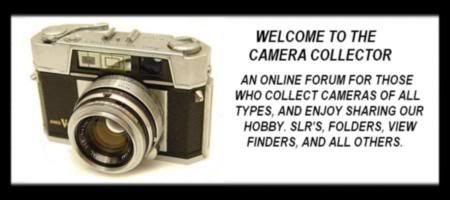|
|
Post by nikkortorokkor on Feb 1, 2011 17:04:06 GMT -5
Having bought just one camera in 2010, I'm gonna brag about my latest acquisition. On Monday evening I did a 200 km drive, taking in some very narrow (one lane) mountain roads to pick up this beauty:  Well, truth be told, I don't find the AGFA Ambi Silette that beautiful to look at, though it is a very interesting camera. I think that the designers of the Silette range at AGFA had really the swallowed the Raymond Loewy "cover it up" school of thought hook line and sinker. Most obvious is the infamous flap over the rangefinder. 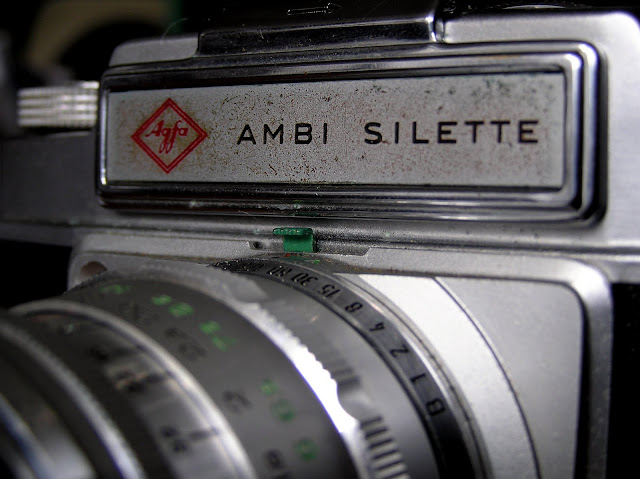 But other, less obvious evidence of the Silette aesthetic reveals itself on closer inspection. No strap lugs or even screw heads adorn the Ambi's exterior. There are nice little touches to make life easier. The bayonet lens mount is, as Steve Grandy suggests, elegance personified. The viewfinder, with its parallax correcting, interchangeable brightlines (35, 50 and 90mm) and bright rangefinder patch, is a gem. 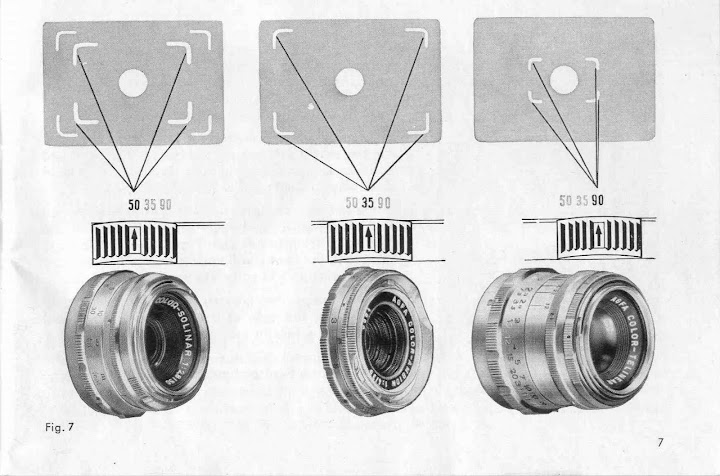 The shutter release is beautifully scupltured. The Compur Synchro shutter is very, very silky, quieter even than the same shutter fitted to the Diax IIb. There is even a little pull out tab to stabilize the camera on a table or shelf when fitted with a tele. No need to pop a lens cap or film can cap under the lens to stop it tipping forward. 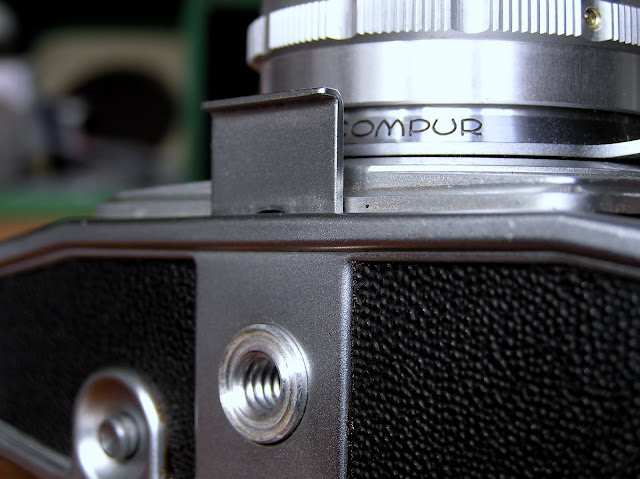 The accessories - Proximeter, lens hood, filters and even the wonderful lens storage bubble are of superb quality. The latter features an alloy lens mount, is sealed with an o ring, and even has silica gel encased within its base. Unfortunately, the Ambi's over-styling reveals itself in one crucial (to me, anyhow) flaw - the wind lever. It's beautifully made but 'orrible to use. The designers tucked it in against the camera back to sync in with the overall streamlined aesthetic. 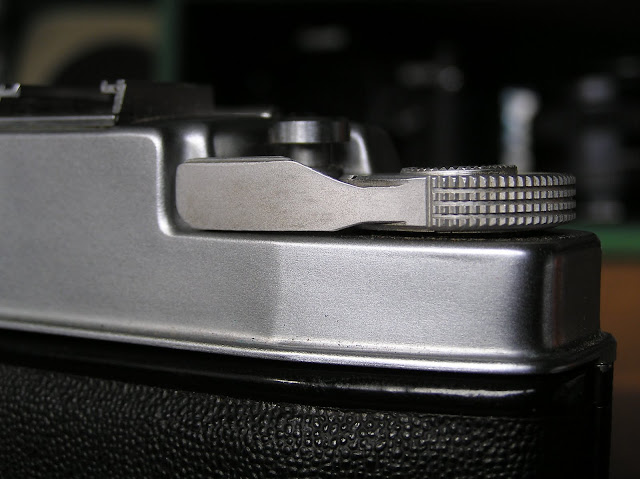 The placement of knurling on top of the lever shows how it is intended to be used, as does the manual. 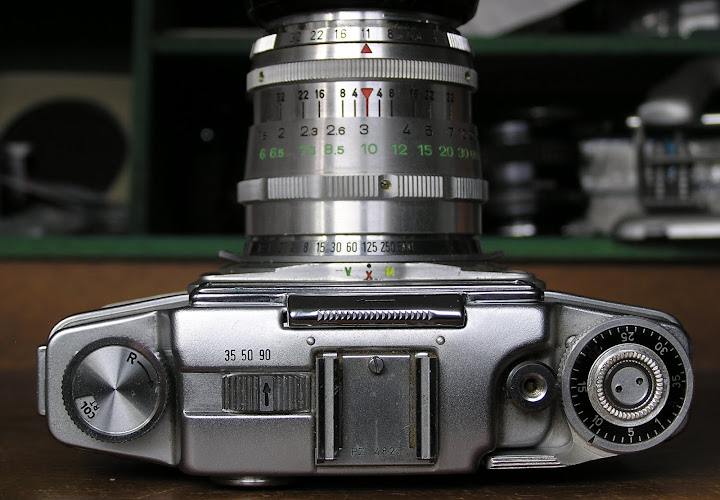 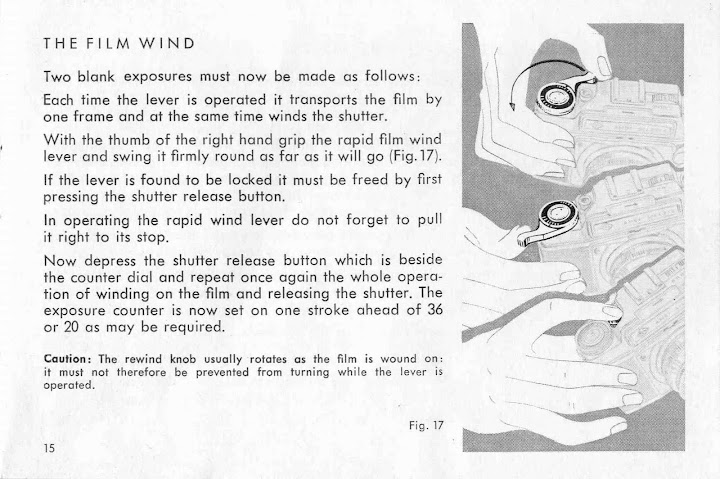 You begin the wind with your thumb on top over the lever, not at its tip. I find this very awkward to achieve while keeping my eye at the viewfinder window (perhaps because I'm a left eye shooter). If I was using an Ambi seriously, I'd consider modifying this Achilles' heel. I am, however, very pleased to get the Ambi, which came with a Color-Solinar 2.8/50 and a Color-Telinear 4/90, the accessories mentioned, an AGFAlux flash and a functioning Weston Master II, all packed in a high quality leather bag. Worth the drive and NZ$111 paid. I'm definitely going to hunt down an f4/35mm Color-Ambion wide-angle when I'm again feeling rich. The Ambi obviously belonged to an enthusiast and came with a roll of Fuji Superior which expired in '97. The camera was either cleaned about then or kept very safe and dry - the viewfinder and lenses are crystal clear and everything is buttery smooth. Just a little external grime to show it isn't brand new. Perhaps that slick design aesthetic is more than skin deep. Michael. |
|
Doug T.
Lifetime Member
   Pettin' The Gator
Pettin' The Gator
Posts: 1,199
|
Post by Doug T. on Feb 1, 2011 17:58:05 GMT -5
Michael, That's a fine looking camera. I've always liked the look of Agfa products, and enjoy using them as well. The better made ones give great results. Ive gone through a few Yashica rangefinders, some of which had cracked viewfinder glass. A cover such as the one on your camera would have prevented that from happening. Looking forward to some shots from your Ambi  Doug |
|
|
|
Post by nikonbob on Feb 1, 2011 19:10:46 GMT -5
Michael
Between this thread and the Retina one they have wanting to add to my collection. I can see why you did the 200 km drive, looks well worth it.
Bob
|
|
Deleted
Deleted Member
Posts: 0
|
Post by Deleted on Feb 1, 2011 21:56:03 GMT -5
It has the same film advance lever and shutter release button as my Ansco Super Memar (made by Agfa) but the Memar doesn't have interchangable lenses.
W.
|
|
|
|
Post by nikkortorokkor on Feb 2, 2011 1:31:10 GMT -5
Doug, I don't actually mind the flap too much and you could be right: the viewfinder is very clear for a 50 year old camera, and I'm always smudging the front element on rangefinders with my fingers, which the flap prevents. I don't find flicking the gate open any more than I do taking the lens cap of an SLR - and it can be done easily "at the eye".
Bob, I too have been looking at Retinas, but my wallet says no for the moment!
I've dry fired the Ambi a few times and despite the lever, it feels nice and makes me itch to get a film into it. I'll post results when I do.
Wayne, I think from Peter W's excellent site that the Super Memar is a rebadged Super Silette. It looks functionally identical to the Ambi, save the lack of an IC lens or brightlines - or the flap!
Michael.
|
|
|
|
Post by nikkortorokkor on Feb 12, 2011 3:37:54 GMT -5
Update:
I have put a film (Fuji 200 Print) through the AGFA Ambi Silette. It is yet to be processed.
Impressions:
The viewfinder 'flap' is not too much of a pain - especially if I remember to flip it with my index finger when confronted by a black finder! Most of the time I admit to dropping the camera to chest level before flipping the flap open - a totally unnecessary move.
The winder is truly horrible when compared to that king of winders, the Minolta XE1. On the other hand, it wound on a complete film without mishap, unlike my contemporary Braun Super Paxette III Automatic, which has eaten two films in succession now (if I ever use that camera again, I'll tape the leader to the take-up spool).
The crankless rewind knob is slow compared to contemporary Japanese fare, but again, quicker than any Braun rewind lever foolishness.
The finder is beautiful. Brightlines and parallax correction! This is enough to turn Voightlander Vito BL users green with envy. The rangefinder a fraction off at infinity, but is otherwise excellent, with a sufficiently bright patch. It is perhaps a tad slower to use than the finder on the Diax IIb, which is somehow the most instinctive I've used. I think that this is perhaps a function of rangefinder patch to viewfinder size ratio. i.e., the Diax finder is quite squinty compared to the big, bright finder on the Ambi Silette. Thus, on the Diax, my vision is naturally drawn to the patch, if that makes sense.
The shutter is simply silky and d@mn near silent. I've never owned a Leica, so can't compare. But I cannon imagine a shutter quieter than this. It puts every rangefinder I've owned (about 20, I guess) to shame.
I took a range of photos with the 50 and 90mm lenses. I now know that I want er, need the 35mm/f4 Color Ambion wide-angle.
It is quite clear that given a few rolls (perhaps unlikely in this digital age) the AGFA Ambi Silette would become a slick rangefinder to use, despite one or two foibles.
A professional (press) photographer and travel writer happened to stay with me last week. When he saw the Ambi, he confessed to lusting after one as a youth in the late fifties. I can understand why. A poor man's Leica? Perhaps.
Pics to come (as long as there were no light leaks or similar disasters).
|
|
|
|
Post by nikonbob on Feb 12, 2011 7:30:17 GMT -5
Fingers crossed about those films then.
Bob
|
|
|
|
Post by lacayote on Jul 19, 2012 22:33:29 GMT -5
Just joined the Camera Collector Forum and was browsing through when I saw Michael's acquisition (Feb 21, 1911) and cannot help to follow it up with a little bragging myself. I too have an Ambi Silette; it was given to me by my father. Through the years I have acquired all the three lenses and I have been taking pictures for many, many years and I just love the camera. Recently I found out the there is also a 130mm lens for this camera!! and I was so lucky, so lucky to find that lens on e-bay. I bought it for $125.00!! and don't regret it. I just have to start taking pictures with it ... soon. Thought you might like to know this tid-bit
Egmond
|
|
|
|
Post by camerastoomany on Jul 20, 2012 10:33:25 GMT -5
I bought one in 2007. The day after it arrived I loaded up with a 12 exp. roll of expired Fuji Superia 100 and headed for town to try it out. with 10 frames exposed, I dropped into a one hour lab, finishing off the film with a couple of shots of one of the owners (the wife). Whilst talking to owner number 2 (the husband), I rewound the film. And rewound. And rewound. I assumed that I hadn't noticed when the film fully rewound because I was talking, so opened the back.
I was still talking and the brain was in neutral. I stood there for several seconds just staring, before reclosing the back. Sigh. I went through the rewind procedure again. No problem.
I had the film developed anyway and the first four frames were unaffected by exposure to light. Sharp with nice colour.
I haven't used the camera since. Too many cameras, not enough time (or money).
|
|
daveh
Lifetime Member
  
Posts: 4,696
|
Post by daveh on Jul 20, 2012 12:08:04 GMT -5
Too many cameras, not enough time (or money). Your "call sign" gives us a hint that might be the case.  I wonder why the instruction manual puts the lens size selector in the order 50 35 90, yet on the camera itself it's 35 50 90. Vorsprung durch Technik perhaps, or just a case of dummkoph? Egmond, let's see some of those photos. |
|
mickeyobe
Lifetime Member
   Resident President
Resident President
Posts: 7,280
|
Post by mickeyobe on Jul 20, 2012 14:21:52 GMT -5
Michael,
That is the same way one winds an Exakta except the Exakta is wound with the left hand. A trifle more difficult for right handed people.
You will find that you grow accustomed to it very quickly.
Exakta never gave us users instructions but the movements are quite natural.
Mickey
|
|
|
|
Post by nikkortorokkor on Jul 20, 2012 23:06:37 GMT -5
Welcome Egmond. That 130mm must be a rare beast. I've owned various 135mm lenses for Braun Paxettes, they are not for action-freaks that's for sure! I'd hazard a guess, however, that the Ambi Silette will be somewhat easier to use with a longer lens due to its superior rangefinder.
Mickey, though I'm right-handed, I'm left eyed, so the Exacta would probably suit me.
Not like my old BRNO .22 rifle when I was a kid. I must've looked funny reaching over the breech to work the bolt with my left hand. never did get a proper left handed gun, though I owned a Winchester '94 for a while. Not the most accurate of weapons, but near ambidextrous.
Some people learn to shoot, both cameras and guns, with their non-leading eye. I tried it, but it doesn't work if I use the approved, both eyes open method of shooting. As soon as one opens the leading eye (left in my case) it takes over and the viewfinder/gun sight just disappears.
Totally OT, but I'm useless at sequencing things and constantly transpose numbers. Apparently, this is a common trait amongst people who's dominant eye is opposite to their dominant hand (left eyed/right handed or vice versa).
back on topic, my problem with the Agfa is achieving the downward pressure required to start the wind. Away from the eye - no problem, but at the eye it's quite awkward for me.
|
|
daveh
Lifetime Member
  
Posts: 4,696
|
Post by daveh on Jul 21, 2012 0:18:19 GMT -5
I am right-handed but left eye dominant also. My son is even more mixed up. He was probably really left-sided but tends to use his right more. I have known a couple of people who were truly ambidextrous. One particularly could bowl or throw a cricket ball with either arm equally well.
Michael, what you say about transposing numbers and/or letters is proven to be true in many with "crossed-wires". I always wonder in those peoples who write right to left whether the other group becomes the group that has the problem. As for me, I have no problems at all with numbers or letters: particularly not numbers. Maths was always my best subject at school by quite a distance.
|
|
mickeyobe
Lifetime Member
   Resident President
Resident President
Posts: 7,280
|
Post by mickeyobe on Jul 21, 2012 0:29:40 GMT -5
Michael, After reading "back on topic, my problem with the Agfa is achieving the downward pressure required to start the wind. Away from the eye - no problem, but at the eye it's quite awkward for me."
I had to get a film camera and wind and shoot, wind and shoot. I don't believe I ever wind with the camera held at my eye. Perhaps that is a left over from my Exakta days with the no return mirror and a lever that required a 360° throw or do you do it as a special technique? I wonder how many people do shoot that way. By the way, the way I shoot and lower camera immediately resulted in many ruined pictures on my first digital, a point and shoot Fujifilm. I could not adapt to the cursed shutter delay and got rid of the camera in short order. I just picked up my K-5. No film advance lever. Little guy inside the camera does it for me. Yes, now I can and do shoot several pictures without removing the camera from my eye. But I still couldn't capture that bumble bee in flight. I continue to remove the camera from my face after most pictures. Now it is often to check my picture on the LCD screen. Mickey  |
|
|
|
Post by yfnr on Sept 8, 2012 13:52:45 GMT -5
I have only been on collector websites for a few days, and I have already seen the Agfa Ambi Silette mount referred to as a "bayonet mount" on at least three of them. Cameraquest.com/agfambi refers to it as a "WONDERFUL bayonet mount". I will agree that the mount is pretty nifty, but it isn't a bayonet. Take another look at the picture of that mount over at agfambi. There are no bayonet lugs poking into the mount from any direction. It can't be a bayonet mount. Nor is it a screw mount. I suppose that it could be called a clamping mount. It is unlike anything else in photography, to the best of my knowledge.
There are only two interruptions to the symmetry of that mount. One of them, shown clearly in the agfambi photo, is a small button-shaped cam. It moves inward and outward from the camera body. It connects the focusing mechanism on the lens with the rangefinder in the body. We do not have to consider it any further.
The other one is directly opposite the focusing cam. Owing to the way the agfambi photo is illuminated, you have to look twice to see it. It is a rectangular cam, which we can call the lens mounting cam, because that is what it is for.
To mount a lens: put the lens more-or-less on the front of the body and spin it clockwise, as seen from the front. In less than one full turn, a notch on the lens will line up with the lens mounting cam, and the lens will drop onto the body as the cam slips into the notch.
Keep twisting the lens clockwise. The lens mounting cam will be carried along in its notch through a very short stroke, only about twenty degrees. During this stroke a set of "extra-heavy-duty extra-thick aperture blades" in the body will "stop down" into a groove around the lens. Those blades don't really have anything to do with the light path in the lens, of course. They clamp the lens onto the body.
With a click, the lens mounting cam will lock into position. It still rides in its notch on the lens, and it will then prevent the lens from turning. You can twist the focusing ring or the aperture ring hamhandedly against their stops without worrying about accidentally spinning the lens upside-down.
To release a lens: push in on the small button at the bottom of the lens mount. This unlocks the lens mounting cam. You can then spin the lens about twenty degrees counterclockwise to move the mounting cam - still in its notch - back to its starting position. The lens mounting blades will open up to full aperture (of the mount, not the lens) and you can pluck the lens off of the body.
This has to be the easiest mount to use of all lens mounts ever made. You don't have to fumble with lining up screw threads. You don't have to match a red dot on the body with one on the lens; there are no red dots, because none are needed.
Disadvantages? Making and assembling all of the precisely-shaped moving parts has to be expensive. And the clamping area is relatively small, which may be one reason why no long, heavy telephoto lenses were ever made in Ambi Silette mount. But there would be no problem in adding electronic contacts to an updated version of this mount, and telephoto or zoom lenses these days aren't all that big or heavy. Maybe, someday . . .
Same camera, different topic: did you buy your 130 mm telephoto lens in an original brown Agfa lens case? You just might own the 130 mm viewfinder without realizing it. There is a "secret compartment" in the lid of that case which accommodates the viewfinder very nicely. Some years ago I was seduced into buying an Ambi Silette system - body, three lenses, cases - by the beautiful Leica-like action of the shutter release. I didn't know that I had bought a viewfinder until after I had bought the system and began to explore it.
No promises, though. That viewfinder is clear, brightlined, parallax-compensated, definitely the finest 130-mm viewfinder ever made for a 35-mm camera. If you got the lens without the finder, then your finder was probably kidnapped to serve as a 135-mm finder on somebody else's Leica camera.
Same camera, third topic: there were two nickpicking modifications to the design during the course of production. The original 35-50-90 viewfinder selector was changed to 50-35-90, and this allowed the 90-mm frame to be displayed by itself. In the earlier version, the 35-mm frame was always displayed, and even in the later cameras it was displayed outside the 50-mm frame. Also - and more important, in my opinion - the original sleek, streamlined, hard-to-use advance lever was replaced with a lever that bulged at the end with a strong knurling at the tip. That advance lever is much easier to use.
Marginal note: I have owned two other cameras that were built on the same body casting. One of them is an Agfa Silette SL, with a fixed-mount 50 f/2.8 lens (same as the interchangeable Ambi Silette optic), a Prontor 1 - 1/300 shutter, and no rangefinder. Instead the space in the top of the body is used for a coupled selenium light meter, which still works OK on my example. The other one was stamped "made in Germany for Ansco", with a fixed-mount f/3.5 lens and a Prontor shutter. Mine no longer functions.
Your Friendly Neighborhood Railfan
|
|









